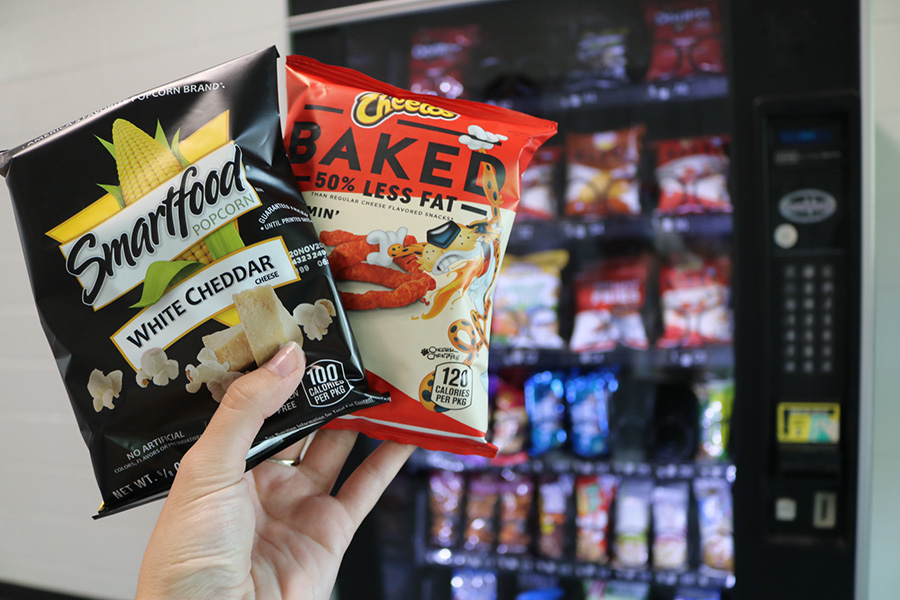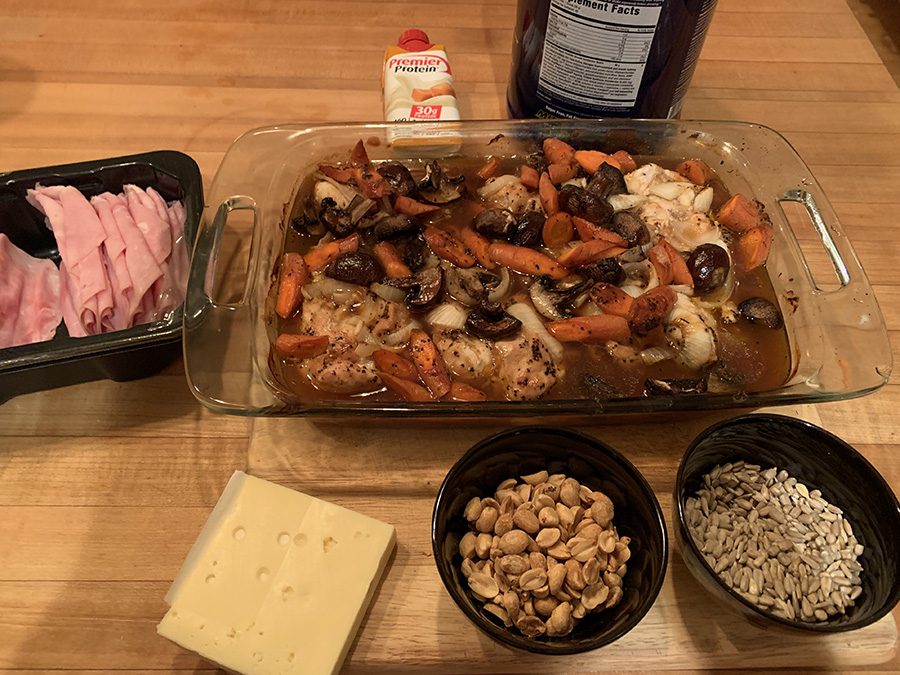Macros
October 15, 2018

Student stands in front of the vending machine holding a “healthy” option of popcorn and “healthier” version of cheetos. The problem with the failed diets and regimens are actually the carbohydrates and everything they do to the body.
Rethinking the regimen, Part one
Carbs cause chaos
The evidence is irrefutable. The United States is statistically the most overweight country in the world. In the face of this mounting evidence, we’ve been told that we simply need to exercise more and eat less. We’ve been taught the “food pyramid” and “calories in vs. calories out.” I would ask you, how is that approach working for us collectively?
Time after time we begin our latest diet with the best of intentions. This one is going to work! It “sounds” right. Yet when the latest effort fails, we don’t think to question the diet. No, we turn around and berate ourselves for not having sufficient willpower or not enough self-discipline.
A recent study reports that 80% of dieters regain every pound they lost with the majority of them getting back even more than they lost. Does this sound like success to you? This doesn’t even take into account the people who didn’t lose weight to begin with. Why should you or I be dependent on someone else’s goods and services to give the temporary illusion of success? Again does this sound like a successful approach?
The problem starts with carbohydrates. When we eat all the various forms of carbohydrate (grains, starches, fruits, vegetables and all forms of sugar) a complex process begins. This has been labeled the metabolic process. These various forms of carbohydrates are converted by the body into one of these forms of sugar, specifically glucose. Different forms of carbohydrates have varying impacts on our blood sugar level.
Your body utilizes these carbohydrates and makes glucose. This of course causes a rise in your blood sugar levels. These particular cells have a very limited capacity to use and store sugar.
We eat sugar and other carbohydrates regularly as a normal part of our diet just as we have been instructed. How many times have you been told to eat lots of fruits and vegetables and make sure you get lots of healthy whole grains? As a result more glucose (blood sugar) can be stored in your growth tissue and it builds up in your bloodstream.
Your body is producing more more insulin because you’re constantly eating various forms of sugars, starches, and grains. The insulin receptors cells become increasingly tolerant to insulin. These cells become less receptive and insulin signals are lost. This causes your body to produce even more insulin in an unsuccessful attempt to lower your blood sugar level. This can lead to insulin resistance which could cause Type-2 Diabetes.
When your body becomes insulin resistant, it makes it near impossible to burn what’s in your fat storages. This is why most people who go on these “diets” can never lose fat, because their body won’t let them. As long as you’re eating some form of carbohydrates, it makes it more difficult to burn fat.
Fibrous carbohydrates are the only carbs that have very little impact on a sugar levels. Fibrous carbohydrates are also known as cruciferous vegetables. We eat these types of carbs for dietary fiber and vitamins that are only found in greens.
This could be important information for the future that way, people won’t spend a fortune on diet plans and gym memberships. The root problem can be solved by just watching the carbs that you eat and using fats as your energy source.
Some healthy options for fats are pork steaks (fatty meats), olive oils, peanuts (any nut), seeds, cheese (not nacho cheese), and eggs (yolk). Fat is a nutritionally dense macronutrient and it should be used for a daily energy supply.
Rethinking the regimen, Part two
Fat for fuel
Every food label listed “95% fat free!” and “low fat!” is complete joke, because the macronutrient fat is the most important aspect to a person’s diet. The word ‘fat’ has had a negative connotation to it for decades, yet it’s the biggest piece to the puzzle.
Our bodies are a perfect parallel to a car as far as functionality. The one part of the car I’ll be relating to is the gas mileage. One gram of fat contains nine calories and one gram of carbohydrate contains four calories. Would you rather be driving a car that gets nine miles per gallon or four miles? Our bodies were made to run on healthy fats and the calorie count proves it.
Protein is not an energy source. Its purpose is to rebuild muscle and replace cells. Carbs are also problematic: they cause chaos. Healthy fats (monounsaturated and polyunsaturated) are good for your heart, cholesterol, and overall health. They lower the risks of heart disease, strokes, and blood pressure. The fat absorbs and carries the vitamins and minerals in your body to your brain.
You can eat healthy fats in large quantities and be perfectly fine, but it’s the bad fats that are detrimental to your health. Trans fats and saturated fats consumed in large quantities can be toxic to your body by clogging arteries, increasing inflammation, and possibly causing type two diabetes. Trans and saturated fats increase your blood sugar just like starchy carbs.
The extremes ends of blood sugar and insulin levels which occur in the metabolic syndrome are responsible for the growth of fat, specifically in and around the visceral organs (liver, pancreas, kidneys, and intestines). Visceral fat is useless fat that sits around your organs and makes it harder for them to fully operate and can increase organ failure.
Sugar (glucose) is driven into the cells until they cannot hold any more sugar, at which point the sugar is deposited in your fat cells and signaled not to burn the fat. This is a two-fold negative reaction being caused by excess blood sugar.
If 70 percent of your diet consists of healthy fat and 25 percent of protein, you’ll be a happy camper. The last 5 percent are cruciferous carbs (greens), and they’re harmless. When the majority of the diet consists of fats (remember that nine miles per gallon analogy) you’ll last longer in the day without getting hungry.
Some great quality protein options are protein shakes, whey protein, peanuts, sunflower seeds, cheese, low sodium lunch meats, and chicken. Protein is a very important macronutrient, and it should be consumed, but with the right intentions.
Rethinking the regimen, Part three
Perfect purpose for protein
The word “protein” is heavily associated with the gym because weightlifters drink protein shakes including whey, meal replacement, and mass gainers. People then consume excess amounts of protein because they see weightlifters with six packs consume it. These people use protein with the intention that it’s an energy source thinking it’s “healthy”. The only macronutrient that’s meant for energy is healthy fats.
The macronutrient protein only has one purpose and that’s to rebuild and replace muscle tissue. Once you’ve consumed an excess amount of protein, your body has no use for it so it stuffs it somewhere as fat. Bodybuilders and weightlifters are able to consume larger amounts of protein because they break down their muscle tissue and it needs to be rebuilt. If you’re in the gym six days a week, by all means, eat 200 grams of protein a day, but the average Joe isn’t.
Your body also needs protein to help with other bodily functions, so don’t deprive yourself of protein completely. Throughout the day consume protein to feed your muscles, but don’t rely on it for energy. The macronutrient protein only has four calories per gram and fats contain nine calories per gram. You’ll get a lot further on nine miles per gallon than four miles per gallon. Protein should be used as an energy source as a last resort for a quick burst of energy, but it’s not efficient.
The best time to use protein is as soon as you wake up and after a workout. As soon as you wake up your body has been asleep fasting and it’s nutrient deprived. If you drink a small protein shake when you wake up it’ll be the first that your body absorbs and it’ll essentially coat your muscles. Another perfect time to consume protein is 30-45 minutes post-workout because your muscles are tired and hungry. The protein will essentially go straight to your muscles and rebuild them.
Carbohydrates and fats are difficult and complex, yet protein is so simple with a single purpose.


